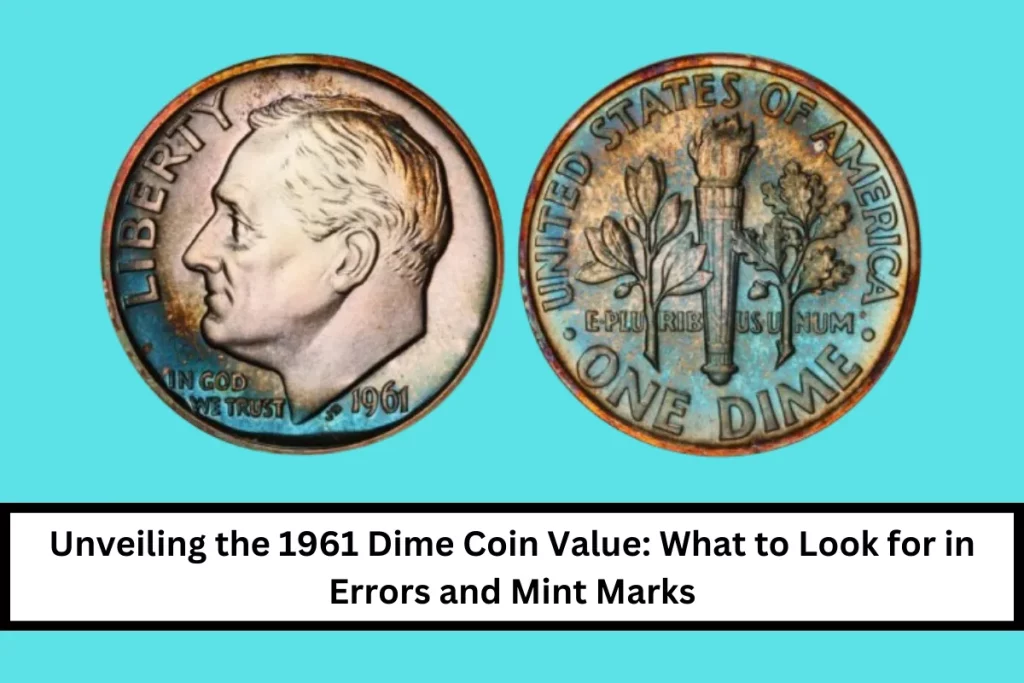The 1961 dime coin is a popular item among collectors. If you’re looking to understand its value, it’s essential to know about its errors, mint marks, and the various factors that contribute to its worth. In this guide, we will explore the 1961 Dime coin value, including the significance of the “D” mint mark and coins with no mint mark.
Understanding the 1961 Dime Coin
The 1961 dime is a part of the United States’ iconic series of coins. Made of 90% silver and 10% copper, it was minted during a time when silver coins were still in circulation. With a weight of 2.5 grams and a diameter of 17.91mm, this coin has become a key collectible.
1961 Dime with “D” Mint Mark
The “D” mint mark refers to coins minted at the Denver Mint. Many 1961 dimes have this mint mark, which can impact the coin’s overall value. Coins with the “D” mint mark were produced in large quantities, but some variations are still valuable for collectors.
Key facts about the 1961 “D” dime coin:
- It was minted in high numbers, making it less rare.
- Condition plays a vital role in its value.
- Uncirculated dimes can fetch higher prices.
1961 Dime without a Mint Mark
The 1961 dime without a mint mark, known as the “No Mint Mark” variety, was produced at the Philadelphia Mint. This coin is slightly more sought after, as it was minted in fewer quantities compared to the “D” variety.
Why the No Mint Mark coin matters:
- It signifies production at the Philadelphia Mint.
- Lower production numbers make it more valuable.
- Rare versions in good condition can command higher prices.
The Errors List for the 1961 Dime
Error coins are often the most exciting for collectors. The 1961 dime has several notable errors that can increase its value. These mistakes can make a coin much more valuable than a regular one. Let’s look at the key errors to watch out for.
1. Off-Center Strikes
An off-center strike happens when the coin is not properly aligned during the minting process. If you find a 1961 dime with this error, it could be worth significantly more. The misalignment gives the coin a unique look, making it rare and valuable.
2. Double Die Obverse
A double die obverse occurs when the die strikes the coin twice, resulting in a blurry or doubled image. This error typically affects the lettering and designs on the front side of the coin. Collectors often pay a premium for these double-die varieties.
3. Die Cracks
Die cracks occur when the die used to mint the coin develops cracks. This can result in unique markings or imperfections on the coin’s surface. A 1961 dime with die cracks can fetch a premium, especially if the cracks are in prominent locations.
4. Missing Letters or Numbers
Sometimes, parts of the design on a coin are not fully struck, leaving parts of the letters or numbers missing. These coins are considered errors and are highly valued by collectors for their rarity.
5. Misplaced Mint Marks
If a 1961 dime features a mint mark in the wrong location, it’s considered a misplaced mint mark error. This rare mistake can make the coin significantly more valuable to collectors.
1961 Dime Coin Value by Condition
The value of a 1961 dime depends heavily on its condition. Like any collectible coin, the better the condition, the higher the value. Coins are graded based on their quality, which ranges from Poor to Mint State.
Condition grading for 1961 dimes:
- Good: Visible wear with clear outlines and details.
- Fine: Slight wear but with most details intact.
- Extremely Fine: Only minimal wear, and most design elements are sharp.
- Uncirculated: No wear, showing full detail and lustrous appearance.
Coins in mint state are the most desirable, especially if they are error varieties.
1961 Dime Value Breakdown
The value of a 1961 dime depends on various factors such as its mint mark, condition, and whether it contains any errors. Let’s break down the typical value range:
- 1961 Dime (No Mint Mark): $2 to $5 in average condition, but errors or high-grade examples can be worth $10 or more.
- 1961 Dime (D Mint Mark): $1 to $3 in average condition.
- 1961 Dime with Errors: Error dimes like off-center or double die can range from $20 to $100 or even higher, depending on the severity of the error and the condition.
FAQs
1. What makes a 1961 dime with errors valuable?
Error coins are rarer and more unique, making them highly sought after by collectors.
2. How can I tell if my 1961 dime has a “D” mint mark?
Look for the small “D” above the date, indicating it was minted in Denver.
3. What is the value of a 1961 dime with no mint mark?
A 1961 dime without a mint mark is generally worth more than a “D” dime, especially in good condition.
4. Can a 1961 dime with a double die obverse be valuable?
Yes, double die errors can significantly increase the value of your 1961 dime.
5. Where can I sell my 1961 dime coin?
You can sell it to coin dealers, online auction platforms, or at local coin shows.

